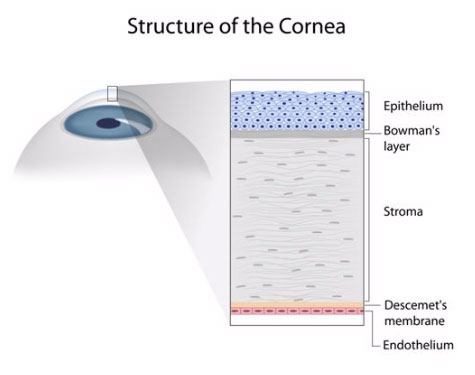Keratoconus
Keratoconus is a condition affecting the cornea in which the cornea weakens and becomes distorted into a cone shape. This affects the focusing ability of the cornea and leads to visual distortion. Keratoconus is typically a bilateral condition associated with hay fever, allergic conjunctivitis and eye rubbing.
Patients with keratoconus will have high levels of astigmatism in their glasses. As the condition worsens they will need to wear rigid contact lenses to attain good vision and a small number of people will need a corneal graft.
Affected patients will typically worsen in their teens and twenties, and stabilize in their thirties. During this high-risk period patients need regular eye checks including corneal scans to monitor for worsening. If your keratoconus is getting worse you’ll be considered for corneal crosslinking.
Corneal Scans
We use a Tomography machine to scan the cornea. This uses a rotating camera to visualize the front and back surfaces of the cornea. With this information it creates topographical maps of the cornea very similar to geographical maps of mountains. Mathematical analysis of each scan and the change between scans is used to determine worsening.
Corneal crosslinking (CXL)
CXL is a treatment to stabilise keratoconus and stop it getting worse which is successful in more than 90% of cases. It is recommended for patients whose corneal scans show that their cornea is getting steeper and/or thinner.
Keratoconus usually stops getting worse by the mid-30s because of natural cross-linking with age so CXL is not normally required for older patients.
Corneal cross-linking is the only treatment currently available to stop keratoconus from getting worse. Evidence from three randomised clinical trials one year after CXL showed success in halting keratoconus progression in over 90% of treated eyes, with over 45% of eyes also gaining an improvement in corneal shape. Longer-term results (up to five years) from another study suggest a similarly high success rate in preventing keratoconus progression; 50% of these patients had a small improvement in vision.
The procedure
Corneal crosslinking is a minor day procedure done with topical anaesthetic. After the cornea is soaked in vitamin B2 (riboflavin) it is exposed to ultraviolet light, which binds collagen fibers morestrongly together and mimics the normal age-related stiffening of the cornea. The procedure takes 45 minutes and afterwards a contact lens is inserted.
Risks
CXL is safe and the risks are minimal, but there is a small chance (about 1 in 30) of worse vision afterwards. After treatment you will still need to wear spectacles or contact lenses.
Normal experiences after the procedure
Your eye will be painful for a couple of days and uncomfortable for a week. The pain is minimized by the insertion of a soft contact lens and topicalanaesthetic drops, however we recommend that you take a week off work. You will have a variety of drops to use after the procedure for one month, which we will give you instructions about.
You will return in one week to have the contact lens removed and to be checked. If you wear contact lenses, you can restart after this appointment. Your vision will initially be hazy and will fluctuate for up to 6 months. We recommend that you don’t get new glasses for this period.

